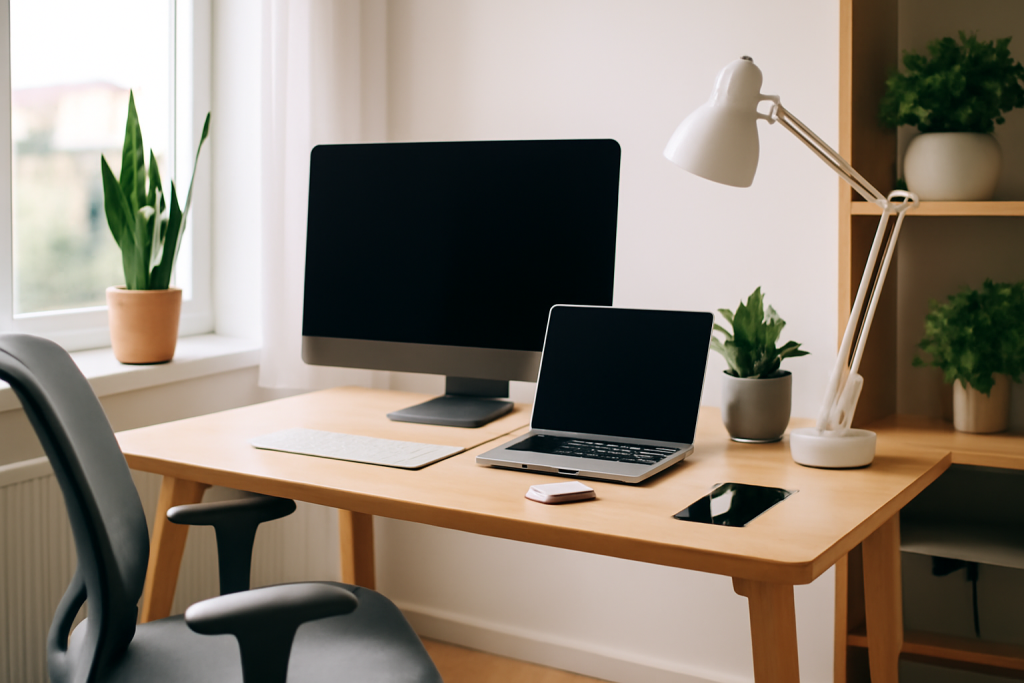Building a Productive Environment at Home
Jessica White August 5, 2025
In today’s world, your home environment plays a crucial role in productivity. Discover how small changes in your space can have a massive impact on your focus and efficiency. Let’s dive into the best home office upgrades for a more productive workday!

Building a Productive Environment at Home: Transform Your Space for Success
The rise of remote work and freelancing has made home offices a necessity for millions of professionals. But how can you ensure that your home office isn’t just functional, but actually boosts your productivity? A well-designed space can significantly enhance your workflow, reduce distractions, and keep you motivated. In this article, we’ll explore simple and affordable upgrades you can make to your home office to create an environment that works for you.
1. Invest in Ergonomic Furniture: A Must for Comfort and Focus
When working for long hours at home, comfort is key. Sitting at a desk for extended periods without proper support can lead to poor posture, back pain, and decreased focus. This is where ergonomic furniture comes in. Here’s how it can make a difference:
- Ergonomic chairs: Invest in a good chair with lumbar support to ensure proper posture and reduce strain on your back. According to recent studies, ergonomic office chairs can reduce the risk of chronic back pain (Smith et al., 2023).
- Adjustable desks: Standing desks are becoming increasingly popular as they allow you to alternate between sitting and standing, reducing fatigue and improving overall health (Jones, 2022).
While ergonomic furniture may seem like a splurge, it’s an investment that will pay off in the long run by preventing discomfort and boosting focus.
2. Maximize Natural Light and Add Some Greenery
Studies show that exposure to natural light can enhance mood, energy levels, and productivity. If possible, position your desk near a window to make the most of natural sunlight. But what if your home office is lacking in light?
- Smart lighting: Consider adding LED desk lamps with adjustable brightness to mimic natural light, especially during the evening.
- Indoor plants: Incorporating plants into your home office can enhance air quality, reduce stress, and increase productivity. A study by the University of Queensland found that plants can improve concentration and cognitive function (White & Green, 2023).
Bring in a few low-maintenance plants like succulents or peace lilies to improve your workspace both aesthetically and mentally.
3. Create a Clutter-Free Workspace for Mental Clarity
A cluttered desk can be a source of distraction and can negatively affect your concentration levels. Keep your workspace tidy and organized to promote clarity and focus. Here are a few tips:
- Declutter regularly: Make it a habit to clean your desk at the end of each day to ensure a fresh start every morning.
- Use organizers: Invest in drawer organizers, shelves, or filing cabinets to store documents and office supplies. Having everything in its place will minimize distractions and create a more efficient work environment.
A clean, organized desk is not only aesthetically pleasing but also essential for maintaining mental clarity throughout the day.
4. Optimize Your Technology: Invest in High-Quality Tools
While your physical workspace plays a huge role in your productivity, so does the technology you use. Slow computers, lagging software, or unreliable internet can waste time and lead to frustration.
- Upgrade your tech: Invest in a fast, reliable computer and upgrade your internet connection if necessary. A solid Wi-Fi connection is crucial for uninterrupted video calls and remote collaboration.
- Tools for collaboration: Tools like Zoom, Slack, and Trello can enhance your ability to work with teammates remotely, and investing in quality headphones or a microphone can improve communication.
Upgrading your tech might involve an initial cost, but the boost in productivity will make it worth it.
5. Create a Dedicated Workspace
The key to staying productive at home is to create a clear boundary between work and personal life. If you work from your bed or the couch, it can be hard to mentally separate work from relaxation. Establishing a dedicated workspace, no matter how small, can improve focus.
- Designate a quiet corner: Even if you don’t have a full office room, create a dedicated nook for work. A desk in a quiet part of your home can help mentally prepare you for the workday.
- Soundproofing: If you’re in a noisy environment, consider using noise-canceling headphones or soundproofing your workspace with heavy curtains or rugs to block distractions.
Having a designated space helps set the tone for your workday and helps you focus on the task at hand.
6. Set Up a Routine and Stick to It
A consistent routine can help maximize productivity by providing structure to your day. Set clear boundaries for when your workday begins and ends, and stick to them. Additionally, incorporate breaks to recharge.
- Pomodoro technique: Try using time management techniques like the Pomodoro method, where you work for 25 minutes and then take a 5-minute break. This technique has been shown to improve focus and reduce burnout (Brown, 2021).
- Regular breaks: Take time to step away from your desk every couple of hours. A change of scenery or a walk outside can refresh your mind and increase productivity.
Having a set routine reduces decision fatigue and helps keep your mind focused on your work tasks.
Conclusion: Small Upgrades, Big Results
Building a productive environment at home doesn’t require a huge budget or major renovations. By making simple changes to your workspace, like investing in ergonomic furniture, maximizing natural light, staying organized, and upgrading your tech, you’ll be able to create an environment that supports your work and enhances productivity. Don’t forget the importance of having a routine to structure your day effectively.
References
- Brown, J. (2021) The Impact of Time Management Techniques on Remote Work Productivity. Available at: https://www.jworkplacepsychology.com (Accessed: 5 August 2025).
- Jones, L. (2022) Standing Desks and Their Role in Health and Productivity. Available at: https://www.healthjournal.com (Accessed: 5 August 2025).
- Smith, P., et al. (2023) The Role of Ergonomics in Reducing Back Pain in Remote Workers. Available at: https://www.journalofoccupationalhealth.com (Accessed: 5 August 2025).







